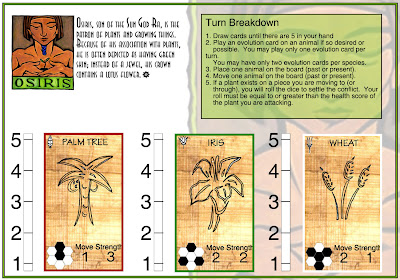Hey everyone, sorry for not being able to make the Monday meeting. However, after reading through the new posts, here's some thoughts I have on the new card balance. First off, the new base scores for all the cards:
Lion/Palm - Move 1, Value 4
Snake/Iris - Move 2, Value 3
Hawk/Wheat - Move 2, Value 2, Can move over pieces without starting conflicts.
I'm still a bit concerned about how there really is only a very slight difference between the tier 2 and 3 creatures. Snake/Iris and Hawk/Wheat. As I'm not sure most playtesters have realized or utilized the "fly" function, and without that, Hawk/Wheat is the weakest piece without any redeeming qualities. So, I'm thinking on how to switch that, but unless we have a bigger game board, bumping up the movement to 3 will overbalance the movement rate. So, very last minute, but something important that Dan Arey pointed out:
Differences in abilities and creatures in the Past vs the Present? Why would I want to play a certain creature or card in the past as compared to the present?
As for the evolution cards, I'm not exactly sure if we should cut down the variety that much, however, I do agree we have to simplify it and make it easier at a glance for the players. We have already cut out Stench, Vines I am hesitant to take out, since the -1 movement range was tweaked to work well as a lock down measure once we put it down to a one hex range. But more importantly, it is a counter to the +1 movement wings mechanic card, but we can also put wings cards in the plant deck too. However, it would be nice to have a little bit of variety between the players to allow them a little more gameplay difference between the two gods. For venom, what I'm worried about is something else that Dan Arey had said:
Are there any cards that would decrease your opponents abilities, or just ones that would increase your own?
So in essence, we have no debuffs, only buff cards. And the closest one to this was the venom card, which was a inverse buff for your creatures, which I really think we should keep. I am proposing to not add any new cards, but at least keep the one debuff card and change the vines card to the same thing, an inverse buff for your opponent. So these two cards would be:
Venom/Poison - Reduce the Base Value of all creatures attacking this evolved creature by one.
Vines - Reduce the Base Movement Speed of animal type by one. This cannot reduce movement to zero.
I'm a little worried about vines, since it is vastly underpowered as compared to wings. I will print this up anyway just in case, but please test this and go from there and see how it affects gameplay. The positive, is that it will be useful on the two faster creatures, but can be used as a counter if used on the 1 movement Lion.
Here are the current balances for each of the decks, I like the balances that Ryan has placed for the cards, and by adding the Venom and Vines card, and then factoring in each of the characters minus the old "power" one, the new decks should look something like:
10 Wheat/Hawk
8 Iris/Snake
6 Palm/Lion
1 Camoflauge
1 Wings/Vines
2 Parasite
2 Spines
2 Venom
This brings it up to: 24 creature cards and 8 evolution cards. It's a little annoying to have to tier the creatures by 2, but with the "Golden" 3:1 ratio that MTG uses, I think it would be a pretty safe bet. And by factoring in the draw one card a turn and discard down to five, it'll be simple to keep in card rotation.












